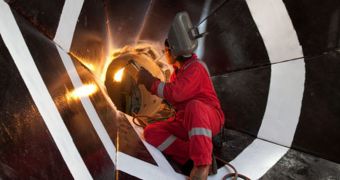Scientists with the IODP initiative this year conducted a new expedition off the coasts of Canada, in a bid to install a sensor network deep under the ocean floor. The array will be used for running innovative, cutting-edge marine experiments.
The team spent about two months aboard the scientific research vessel JOIDES Resolution, in waters off British Columbia. During this time, marine geologists drilled deep holes into the ocean floors, and installed advanced scientific equipment within.
The effort was called the Integrated Ocean Drilling Program (IODP) “Juan de Fuca Ridge-Flank Hydrogeology” expedition, and was carried out between July 9 and September 5.
The boreholes that were made under the ocean surface reached a depth of as much as 530 meters, or no more than 1,800 feet. The observatories were then installed within.
“The ocean crust is the largest aquifer on the planet,” explains Andy Fisher, who was the co-chief scientist of Expedition 327.
“We know it's made up of many sections, but we have no idea how these parts connect or how they interact with one another. The observatories will help us find answers,” adds the scientist, who holds an appointment at the University of California in Santa Cruz (UCSC).
He says that the CORK observatories, aptly named seeing how they are used to seal boreholes, were installed west of Vancouver Island, Canada, at a distance of about 200 kilometers.
“Expedition 327 has completed some of the most complex borehole observatory installations ever attempted,” explains scientist Jamie Allan.
He is the program director of the National Science Foundation's (NSF) Division of Ocean Sciences (DOS). This organization is responsible for funding the IODP.
“These observatories will measure directly, within the oceanic crust, key characteristics that govern an unseen, remote, yet geographically widespread biological world, and will support long-term chemical and biological sampling and environmental monitoring of this exotic habitat,” he adds.
The Integrated Ocean Drilling Program (IODP) is an international research program, which is dedicated to advancing scientific understanding of the planet.
This is done through drilling, coring, and monitoring the area immediately below the seafloor. The CORK devices play a critical part, because they are capable of collecting data at multiple depths.
This allows them to gain new data on the waters, pressures, temperatures, chemistry, and microbiology within the rocks and sediments of the ocean crust.

 14 DAY TRIAL //
14 DAY TRIAL //